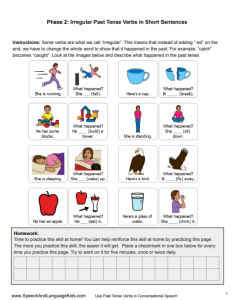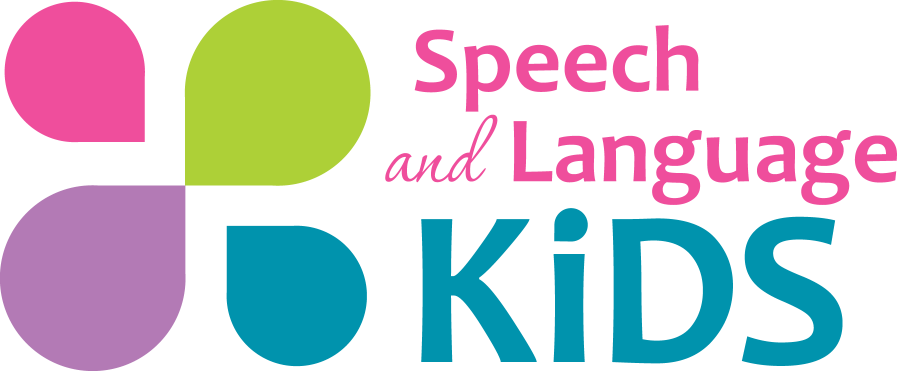Present Progressive “-ing” | Speech Therapy Activities for Progressive Verbs
She is jumping.
He is running.
How can we teach children to use the present progressive “-ing” verb tense?
On this page, we’ll give you a simple, step-by-step process for teaching present progressive “-ing” verbs to children. We’ll show you our favorite speech therapy activities for teaching this grammatical skill.
What is the Present Progressive “-ing” Verb Tense?
The present progressive “-ing” grammatical marker is the one we tack on the end of a verb to say that the action is currently happening. For example, we might say “he is running” or “she is flying”. When a child does not use the “-ing” ending on present progressive verbs, it can be hard for the listener to determine the exact meaning of the sentence and can make the child’s speech sound telegraphic or choppy.
Speech Therapy Activities for Present Progressive “-ing”
Step 1. Using Present Progressive “-ing” in Single Words
First we need to teach your child to include the “-ing” on simple verbs. You will need a set of pictures of children or adults performing different actions. You can make your own by finding pictures online and printing them out or you can download mine for free:
Show your child one picture and say “what is she doing?” Your child should already know the name of the action that the person is doing. If not, go back and teach those first. Your child will probably say the action word without using the “-ing” on the end. For example, if you say “what is she doing?”, your child may say “sit”. Repeat the word back to your child but add the “- ing” to the end. You can say “Sitting. She is sitting.” Then, have your child repeat “sitting” back to you. Do the same thing for each picture. Model the correct “-ing” form of the verb for each one. As you continue to do this, your child should begin to include the “-ing” on some of them by herself. Once she can label the cards using an “-ing” ending, start asking her the same question about other pictures or real people. If you see someone at the park, ask your child “what is she doing?” and help her respond with the correct “-ing” on the end. The more places you can do this with your child, the quicker she will learn to use it and generalize it to other settings.
Step 2. Using Present Progressive “-ing” in Sentences
Now that your child knows how to use the “-ing”, let’s bump it up to saying it in sentences. Get out the action pictures you used from step one again but this time prompt your child with “tell me about this picture”. The response we are looking for now is a full sentence about what the person in the picture is doing. The first several times you do this, you will need to tell him the answer and let him repeat it back to you. He will be used to saying just the single word and it will take some practice to get the whole sentence out. If you know the name of the character or person in the picture, you can say her name when you describe what she’s doing, such as “Dora is jumping”. If not, you can say “he” or “she”.
If your child is having trouble with “he” and “she”, now would be a great time to work on those as well. Just make sure you don’t lose sight of whether your child is using the “- ing” on the verb. After having your child repeat the answer back to you several times, try asking him one and see if he will give you the whole sentence on his own. If he just tells you the name of the action again, you can prompt him by saying “use all of your words” and then get him started by saying “he…” and let him finish. Eventually, he should be able to create these sentences all on his own.
Step 3. Using Present Progressive “-ing” in Conversation
Your child is moving right along! Time to start working on using that “-ing” in conversational speech. Start listening to your child’s conversational speech and see if she’s using that great “-ing” yet. If she is already using it just from practicing those sentences, then you’re good to go! Chances are though, she’ll need a little more help to get there. Start correcting those “-ing” verbs when you hear her use them incorrectly in conversational speech. Start by just correcting about 10% of the errors you hear. This will ease her into being corrected without overwhelming her.
Then, slowly increase the percentage of time that you correct her. As you increase the frequency of your corrections, she should also begin doing more on her own. By the time you’re correcting 80-90% of the errors you hear, she shouldn’t be making many errors anymore so you’re still only correcting her every once in a while. Keep doing this until your child is able to use the present progressive “-ing” in conversational speech about 80% of the time.
After that, you can just monitor to make sure she doesn’t start forgetting again. If she does, get out some of these activities to practice as a refresher. Modification: If your child is having trouble with this, go back and practice using the “-ing” in pictures again every once in a while but still keep correcting her in conversational speech. This may give her the extra boost she needs to remember to do it more often. Use a variety of books and other media to give her plenty of different type of practice on this skill.
A Structured Program for Teaching Grammar Skills to Children:
Improving grammar skills in children doesn’t have to be so overwhelming or time consuming.
We have a complete Grammar Curriculum inside the SLK Curriculum that gives you everything you need to teach grammar skills systematically.
No more stringing together random activities and hoping for the best.
With a structured curriculum, you’ll know exactly what to teach next and you’ll have all the materials and resources you need for faster progress and easier sessions.

About the Author: Carrie Clark, MA CCC-SLP
Hi, I’m Carrie! I’m a speech-language pathologist from Columbia, Missouri, USA. I’ve worked with children and teenagers of all ages in schools, preschools, and even my own private practice. I love digging through the research on speech and language topics and breaking it down into step-by-step plans for my followers.
Connect with Me:




What’s new or different about this? This is S-LP 101 from the 1970’s. Please don’t feel the need to publish unless you have something creative to add to our practice.
I’m glad you agree that this procedure works for teaching children the skill. This website is designed primarily for parents of children with speech and language impairments who don’t have the training that you and I do. If you are looking for advanced or novel approaches, this website may not be for you.
As a SLP graduate student looking for therapy activities, I found this post extremely helpful. Please direct me to where you post all of your creative ideas that you add to the practice of speech-language pathology, because I googled your name and was unable to find anything other than a Linkedin profile. I applaud this young woman for wanting to educate other parents, and, as a by-product, me a grad student. I don’t mean to be rude, but you are not the only experienced SLP that I have encountered that feels the need to criticize newer SLPs and frankly gives the profession a bad rap.
I am a SLP and I find this very informative and helpful. Thank you.
That’s wonderful! Thank you for reading!
I enjoy your website very much. It is full of a lot of valuable information. I am an SLP and enjoy seeing what other SLPs do in their practice and learnng from them. I appreciate all you are doing here!
Absolutely!! I’m glad you’re enjoying it!
Hi! I am also an SLP and have found this sight helpful. Our language course in grad school was taught from the textbook. I find that I have missed out on some essentials. Thank you for helping to fill in the blanks!
In my opinion, Grad school does a great job of teaching the basics and the theories but is often lacking in the “how-to”. That’s where I come in!
this is very good and child friendly playful way of learning. thanks for introducing it to us.
No problem!
I am not a speech pathologist; I am a preschool teacher looking for ideas to “educate” parents of young children. I really find this information very helpful. Thank you very much
You are very welcome, Angeles! Please reach out if we can help answer any questions that you may have.
I found this very helpful. A lot of this stuff is not basic for new SLPs. We didn’t learn a lot of the therapy stuff in grad school. I really appreciate you taking the time to break down these goals so we are able to implement them immediately into our practice. Thank you!
You are most welcome, Alycia! Please reach out with any questions that may arise. We are here to help!